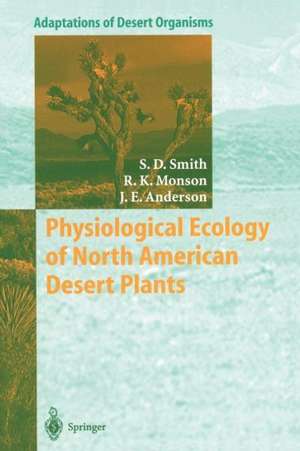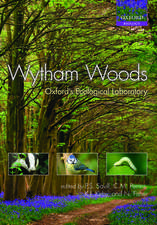Physiological Ecology of North American Desert Plants: Adaptations of Desert Organisms
Autor Stanley D. Smith, Russell Monson, Jay E. Andersonen Limba Engleză Paperback – 16 oct 2012
Din seria Adaptations of Desert Organisms
- 18%
 Preț: 954.14 lei
Preț: 954.14 lei - 18%
 Preț: 948.29 lei
Preț: 948.29 lei - 18%
 Preț: 945.92 lei
Preț: 945.92 lei - 18%
 Preț: 947.35 lei
Preț: 947.35 lei - 18%
 Preț: 1384.44 lei
Preț: 1384.44 lei - 18%
 Preț: 946.10 lei
Preț: 946.10 lei - 18%
 Preț: 1212.68 lei
Preț: 1212.68 lei - 18%
 Preț: 953.82 lei
Preț: 953.82 lei - 15%
 Preț: 632.70 lei
Preț: 632.70 lei - 15%
 Preț: 635.31 lei
Preț: 635.31 lei - 15%
 Preț: 639.25 lei
Preț: 639.25 lei - 15%
 Preț: 639.73 lei
Preț: 639.73 lei -
 Preț: 382.57 lei
Preț: 382.57 lei - 15%
 Preț: 636.80 lei
Preț: 636.80 lei - 15%
 Preț: 640.24 lei
Preț: 640.24 lei - 15%
 Preț: 641.03 lei
Preț: 641.03 lei - 15%
 Preț: 636.45 lei
Preț: 636.45 lei - 15%
 Preț: 632.37 lei
Preț: 632.37 lei - 15%
 Preț: 637.28 lei
Preț: 637.28 lei -
 Preț: 378.92 lei
Preț: 378.92 lei - 15%
 Preț: 633.53 lei
Preț: 633.53 lei - 15%
 Preț: 693.71 lei
Preț: 693.71 lei - 15%
 Preț: 636.45 lei
Preț: 636.45 lei - 15%
 Preț: 641.53 lei
Preț: 641.53 lei -
 Preț: 395.63 lei
Preț: 395.63 lei
Preț: 388.34 lei
Nou
Puncte Express: 583
Preț estimativ în valută:
74.31€ • 77.79$ • 61.49£
74.31€ • 77.79$ • 61.49£
Carte tipărită la comandă
Livrare economică 07-21 aprilie
Preluare comenzi: 021 569.72.76
Specificații
ISBN-13: 9783642639005
ISBN-10: 3642639003
Pagini: 300
Ilustrații: VIII, 288 p.
Dimensiuni: 155 x 235 x 17 mm
Greutate: 0.42 kg
Ediția:Softcover reprint of the original 1st ed. 1997
Editura: Springer Berlin, Heidelberg
Colecția Springer
Seria Adaptations of Desert Organisms
Locul publicării:Berlin, Heidelberg, Germany
ISBN-10: 3642639003
Pagini: 300
Ilustrații: VIII, 288 p.
Dimensiuni: 155 x 235 x 17 mm
Greutate: 0.42 kg
Ediția:Softcover reprint of the original 1st ed. 1997
Editura: Springer Berlin, Heidelberg
Colecția Springer
Seria Adaptations of Desert Organisms
Locul publicării:Berlin, Heidelberg, Germany
Public țintă
ResearchCuprins
Prologue.- 1 North American Deserts: Environments and Vegetation.- 1.1 The Deserts of North America.- 1.2 Abiotic Features of North American Deserts.- 1.3 North American Desert Vegetation.- 1.4 Structure and Function of North American Desert Ecosystems.- 2 Plant Processes and Responses to Stress.- 2.1 Photosynthesis in Desert Plants.- 2.2 Desert Plant Water Relations.- 2.3 Desert Plant Growth.- 2.4 Reproduction in Desert Plants.- 2.5 Defense of Desert Plants.- 3 Evergreen Shrubs.- 3.1 Introduction.- 3.2 Case Study: Artemisia tridentata.- 3.3 Case Study: Larrea tridentata.- 3.4 Summary: Adaptations and Environmental Constraints.- 4 Drought-Deciduous Shrubs.- 4.1 Introduction.- 4.2 Case Study: Encelia farinosa.- 4.3 Stem Photosynthetic Shrubs and Trees.- 4.4 Summary: Adaptations and Environmental Constraints.- 5 CAM Succulents.- 5.1 Introduction.- 5.2 Case Study: Carnegiea gigantea.- 5.3 Case Study: Agave deserti.- 5.4 Summary: Adaptations and Environmental Constraints.- 6 Perennial Grasses.- 6.1 Introduction.- 6.2 Architecture of Perennial Grasses.- 6.3 Hypotheses to Account for Selection for Bunchgrass Architecture.- 6.4 Case Study: Leymus cinereus.- 6.5 Summary: Adaptations and Environmental Constraints.- 7 Phreatophytes.- 7.1 Introduction.- 7.2 Case Study: Prosopis glandulosa.- 7.3 Summary: Adaptations and Environmental Constraints.- 8 Desert Annuals.- 8.1 General Distribution of Desert Annuals.- 8.2 Phenological Controls over Growth of Desert Annuals.- 8.3 Plant Carbon and Water Balance of Desert Annuals.- 8.4 Case Study: Machaeranthera gracilis.- 8.5 Case Study: Solar Trackers.- 8.6 Summary: Adaptations and Environmental Constraints.- 9 Poikilohydric Plants.- 9.1 Introduction.- 9.2 Case Study: Selaginella lepidophylla.- 9.3 Summary: Adaptations and Environmental Constraints.- 10 Exotic Plants.- 10.1 Introduction.- 10.2 Case Study: Bromus tectorum.- 10.3 Case Study: Tamarix ramosissima.- 10.4 Summary: Adaptations and Environmental Constraints.- Epilogue.- Desert Adaptation: A Growth Form Perspective.- Global Climate Change: Potential Responses of Desert Ecosystems.- Concluding Remarks.- Acknowledgements.- References.- Species Index.











